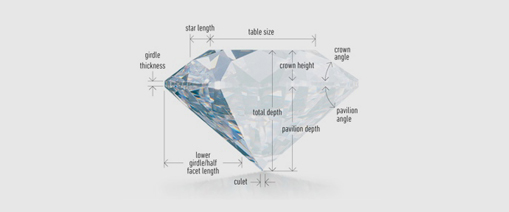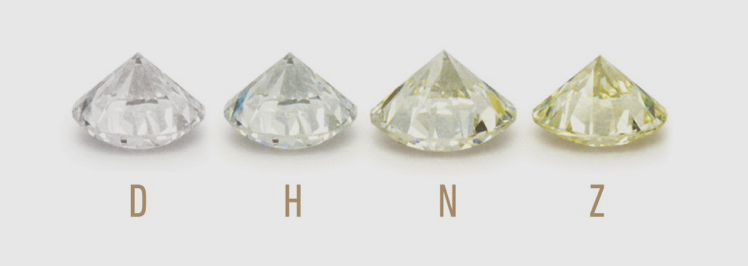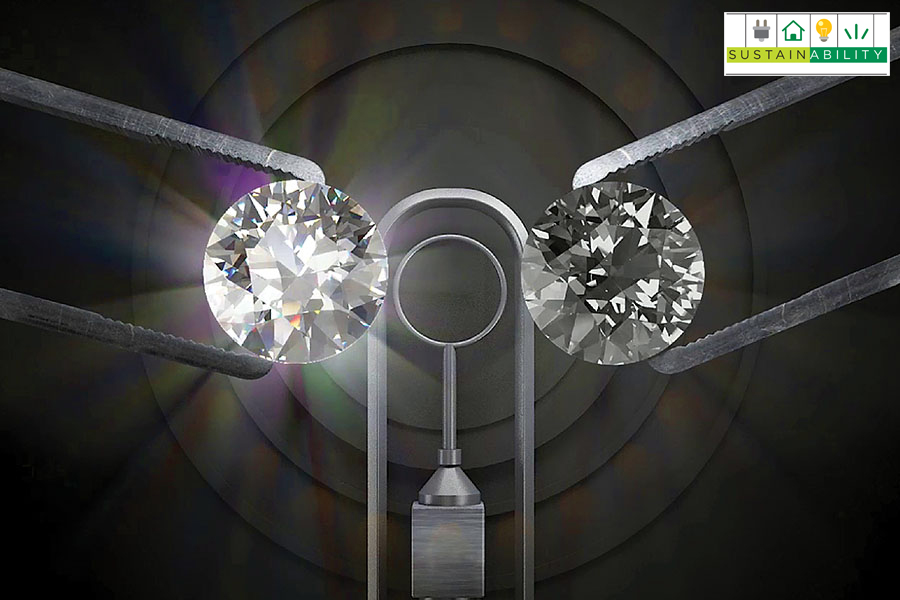DIAMOND EDUCATION & GUIDE
Diamond Education & Guide
CARAT WEIGHT
Carat Weight "is literally the diamond weight. A diamond's Carat weight defines the jewelry's size and appearance.

CERTIFICATION
Certificates are evidence of the identification, purity and value of a diamond. A certificate shall state the exact dimensions, weight, cut and overall consistency of a diamond. A certificate will correctly show the unique characteristics of a diamond and will be a valuable tool when identifying a stone.
Cut.
A diamond 's beauty hinges more on cutting than any other element. Although all the other Cs are essentially decided by Nature, cut is the one which Man can decide. For this reason, cut is perhaps the most important we can understand of the four Cs.
Cut refers to a stone 's proportion, polish, and symmetry: these three factors are crucial in producing a diamond with the best possible reflection of the light. The angles and finishes of any diamond decide their ability and brightness to handle light and its brilliance.
When a diamond is well-cut, light enters through the table and passes to the pavilion, where it bounces from side to side before projecting back through the table and to the eye of the observer from the diamond. This light is the brilliance, and the sparkling blaze makes diamonds so captivating
Brilliance, Fire and Scintillation
A diamond cutting has three primary effects on appearance: Brilliance, Scintillation, and Fire.
Brilliance refers to the brightness of a diamond, produced by integrating both the reflections of white light from the surface and the inside of a polished diamonds. As light reaches the surface of a stone, some light enters and some light is reflected backwards. The amount of light reflected immediately in the back depends on the angles of the crown.
A diamond cut often provides "contrast," the light and dark areas that are seen in a diamond. Such dark areas are not inclusions but shadows formed between the light source and the diamond by the cut.
The larger the amount of light reflected, and the greater the contrasts, the brighter the stone. A round diamond is usually more brilliant than a fancy shape due to the superior round cut mechanics for reflection of light.
Scintillation refers to the light flashes, or sparkles, that are created when a diamond is tilted side by side. These flashes are triggered when light that is not reflected back instantly reaches the diamond and bounces off the inner walls.
The light which reflects from a diamond can appear in brilliant white flashes, or in a colored rainbow, called Fire. The effect of fire is caused by proper bending and light dispersal as it passes through the diamond. The more colorless the diamond is, the more real the scattered colors will appear.
Maximum brilliance is obtained in diamonds with the greatest fire and strongest scintillation.
Cut Grades
Ideal/ Excellent – Excellent light performance. Reflects almost all of the light that enters. Rare and extremely beautiful cuts.
Very Good – Very good light performance. Reflects almost all of the light that enters. Very Good diamond cuts are considered to be an outstanding value.
Good – Good light performance. Reflects most of the light that enters.
Fair – Not as brilliant as a Good cuts or above, Fair diamond cuts are still considered good quality diamonds.
Poor – Poor cut diamonds are typically cut too shallow or too deep causing much of the light to leak out of the diamond's sides and base.
Colour.
COLOUR
We mean the degree of colorlessness when we talk of Color in a diamond. While most diamonds are white, not all of them are completely colorless.
The appearance of a tint in a white diamond is considered undesirable. The impurity of this color is caused by residual traces of nitrogen, boron, hydrogen or other elements. Diamonds are usually only affected by the traces of nitrogen, which produce light yellowish or brownish tints. Only diamonds made up of 100 % pure carbon without impurities can be completely colourless.
Diamonds are rated on a scale of whiteness, or lack of color. In fact, the whiter or clearer the color of a diamond the higher its worth.
Grading
The Gemological Institute of America (GIA) has devised a set of guidelines to grade diamond colour. The colour of graded diamonds is compared to that of control stones, which are preselected gems of a specific colour.
To be graded, diamonds must be loose stones, because once a diamond is set into metal the metal can affect its colour. A lettering system from D to Z is used to identify the amount of colour present in each diamond, with D awarded only to rare, totally colourless diamonds. Many of these colour distinctions are so subtle that they are invisible to the untrained eye. But these slight differences make a very big difference in diamond quality and price.
WHY DOES THE COLOUR GRADING SYSTEM START AT D?
Before GIA developed the D-Z Colour Grading Scale, a variety of other systems were loosely applied. These included letters of the alphabet (A, B and C, with multiple A’s for the best stones). The result of all these grading systems was inconsistent and inaccurate. GIA Colour Scale wanted to start fresh, without any association with earlier systems, they chose to start with the letter D—a letter grade normally not associated with top quality.
CLARITY.
Clarity, or pureness, is the ability of a diamond to let light in and reflect its brilliance. Of the Four Cs, Clarity is the easiest to assess, and the easiest to understand.
We calculate a diamond's clarity by its thickness, and the number of inclusions and defects in or on it. Inclusions are internal anomalies, and exterior anomalies are blemishes. We can often see these only under a powerful microscope or jeweller's loupe, and they do not visibly affect a diamond 's appearance or beauty.
Inclusionsstrong> include defects such as air bubbles, cracks and non-diamond minerals contained inside the diamond, which are induced deep within the earth during its creation.
Big inclusions interfere with light dispersion, which decrease the brilliance of the diamond. These also affect the diamond's toughness, reducing its fracture-resistance.
Blemishesstrong> are imperfections on the outer surface of a stone, which include cracks, holes, which chips. The cutting and polishing method result in certain blemishes such as nicks, holes, trigons, and polishing lines. Most blemishes can be polished away, depending on their position and size, or the diamond can be recut to remove them.
Surface defects may affect the clarity and value of a diamond but many defects have little to no effect on the appearance of a diamond.
Usually blemishes have less impact on the value, appearance and grade of a diamond, as they rarely affect the strength and structure of the diamond.
Clarity Grading
Gemmologists’ grade the clarity of a diamond by examining it top-down with a 10x magnifying microscope. Imperfections located on or beneath the table of the diamond are easier to detect and affect clarity grade more than those located around the sides of the diamond. Larger marks, darker marks and deep marks will also significantly affect the clarity of the diamond.
There are International Diamond Grading System and globally recognized laboratories for diamond clarity assessment. With 11 grades, the system classifies a diamond's clarity based on the nature, position and size of its inclusions and exclusions. The list below summarizes the International Diamond Grading System.
- FLstrong> Flawless: Flawless diamonds have no inclusions or blemishes detectable under 10x magnification, and are extremely rare.
- IFstrong> Internally Flawless: Internally flawless diamonds have no detectable inclusions but some surface blemishes under 10x magnification, and are rare and very valuable.
- VVS1/VVS2strong> Very Very Slightly Included: Inclusions and blemishes are extremely difficult for a even a skilled grader to detect under 10x magnification
- VS1/VS2strong> Very Slightly Included: Inclusions and blemishes are detectable under 10x magnification, but are minor flaws that do not impact the diamond's beauty and are frequently invisible to the naked eye.
- SI1/SI2strong> Slightly Included: Inclusions and blemishes are easily noticeable under 10x magnification and may also be visible to the naked eye.
- I1, I2, I3strong> Included: Inclusions and blemishes are obvious under 10x magnification and typically visible to the naked eye. These flaws may negatively impact the transparency and or brilliance of the diamond.
CARAT.
Carat-Weight
A carat is the weight factor by which a gemstone is measured. A diamond's carat-weight is the simplest to assess of the 4C's. Carat-weight is not a metric that denotes a diamond 's consistency but merely its size by weight.
The word "carat" derives from the carob seeds that people used in ancient times to balance scales. So uniform in shape and weight are these little seeds that even today's sophisticated instruments cannot detect more than three one-thousandths of a difference between them.
"Carat” is not to be confused with "karat," which is used to indicate the purity of gold.
One carat is subdivided into 100 "points". Therefore, a diamond measuring 75 points is 3/4 carat in weight, or 0.75ct. There are five carats in a gram.
The size of a diamond is proportional to the carat-weight of a diamond. When rough diamonds are cut and polished into finished diamonds, as much as 2/3 of the total carat-weight may be lost. Since larger rough gems of high quality are found less frequently than smaller rough gems of high quality, a single two carat diamond will be more expensive than 2 one carat diamonds of the same quality. However, two diamonds of equal carat-weight can differ greatly in value due to their cut, color, and clarity.
Carat-weight by itself will not reflect a diamond’s size. Instead, two other factors must be considered: Distance across the top of the diamond measured in millimetres and the cut grade of the diamond.
Since a diamond is viewed from the top when set into a ring or pendant, determining the distance across the top of a diamond is important. A deeply cut diamond has a higher proportion of its total weight "hidden" in the depth, resulting in a diameter smaller than a well-cut diamond. The amount of light which a diamond reflects depends on its cut grade. Hence, when a diamond is well cut, it reflects full light from the surface and makes it look larger.
NOTE:
Carat is abbreviated to "ct" or "CT" when describing a single stone. "TCW," meaning "total carat weight," is added when jewelry is set with multiple diamonds.
It has to be noted that the carat weight does not refer to exactly one figure. It comprises of stones within a certain weight range. For example:
1 carat - Stones in weight range of 0.95 ct to 1.05 ct
0.75 carat - Stones in weight range of 0.72 ct to 0.76 ct
0.50 carat - Stones in weight range of 0.47 ct to 0.56 ct
0.25 carat - Stones in weight range of 0.23 ct to 0.26 ct
This holds true for all carat weight figures.
SHAPE.
A diamond 's shape is its geometrical appearance, with proportions, finish and symmetry in it. Shape along with cutting determines a diamond's special characteristics
The following are popular shapes of diamonds:
Round Brilliant:
One of the most popular shapes, a round brilliant-cut diamond has 58 facets, which are divided among the crown, girdle and pavilion. A round-cut diamond is very versatile and can accommodate changes in cut, colour and clarity, while retaining its fire and brilliance.
Princess Cut:
A princess-cut diamond is square shaped with pointed corners. Usually, the corner is embellished with triangular stones. Princess-cut diamonds vary considerably in being square or rectangular.
Emerald Cut:
In emerald-cut diamonds, the pavilion is cut with rectangular facets for a unique optical appearance. This cut clearly shows the clarity of the diamond owing to the large open table.
Ascher Cut:
A slight variation of the emerald-cut diamond is the Ascher cut, which is also known as the 'Modified Square Emerald cut'. This cut comprises of a small rectangular table, high crown, deep pavilion, and cut corners.
Marquise Cut:
A marquise-cut diamond is elongated in shape and is named after the Marquise de Pompadour. This diamond looks beautiful when used as a solitaire on a ring and makes the finger look slender.
Oval Cut:
An oval-cut diamond has brilliance similar to a round-cut diamond. It resembles a marquise-cut diamond but with curved edges.
Radiant Cut:
A radiant-cut diamond is a popular choice for jewellery since it has trimmed corners. It can either be a square or rectangular in shape with 70 facets, which can deliver the brilliance similar to a round-cut diamond.
Pear Cut:
A sparkling teardrop, a pear–cut diamond has a single point and rounded end. It is a combination of an oval and marquise cut. While choosing pear-cut diamonds, look for a length-to-width ratio between 1.45 and 1.75.
Heart Cut:
A pear-cut diamond with a cleft at the top forms the heart-cut diamond. A typical heart with 59-facet symmetry has high degree of fire and brilliance, which makes it sparkle brilliantly.
Cushion Cut:
Cushion-cut diamonds, also called pillow-cut or candlelight diamonds, have rounded corners and larger facets to improve the brilliance. In this cut, the diamond’s clarity is well highlighted owing to its larger facets.
Diamond Certification.
A diamond is an excellent investment as a timeless and exquisite gift to yourself or as a symbol of your devotion for another. Since long time the influence of Diamond over emotions and desires has increased.
Diamond grading covers numerous aspects of each individual diamond's qualities. Quality assessments regarding grading are made by independent gemologists’ labs, such as GIA an IGI , and are recognized worldwide.
A certificate is a "blueprint" of a diamond, and tells you the diamond's exact measurements and weight, as well as the details of its clarity, color, polish, symmetry, cut and quality.
A certificate is not the same thing as an appraisal. A certificate describes the quality of a diamond, but it does not place a monetary value on the gem.
A certified diamond comes with a diamond grading report guaranteed by an accredited gem lab. This report assures the customer that the diamond is independently recognized as possessing all the qualities specified by that report. When you buy a certified diamond, you are getting a diamond with beauty and pedigree. You have tangible, legal assurances as to the particular nature and quality of the diamond you are purchasing.
- Shopping for certified diamonds allows you to make an informed choice about your selections, and to comparison shop. You can compare one diamond with a particular weight and quality with other diamonds of similar weight and quality to determine which the better value is.
- A diamond grading report adds an increased comfort-level to your purchase. Because the quality of your purchase has been independently verified, you can feel assured that you have made a wise purchase and that you have received exactly what you have paid for.
- The quality assessments in a certificate are used by appraisers to determine the insurance or replacement value of your diamond.
How do reports from various independent labs compare with one another?
Acquaint yourself with gemological labs before purchasing your diamond. Lab reputations may vary and change over time. Popular labs that certify diamonds and gemstones include:
- Gemological Institute of America (GIA): Many in the diamond industry consider GIA the gold standard of diamond graders. GIA grading reports have been considered to be a hallmark of integrity throughout the diamond world. Established in 1931, the not-for-profit GIA has its headquarters in Carlsbad, California and has a presence in a number of locations worldwide.
- International Gemological Institute (IGI): IGI grades diamonds and gemstones from its headquarters in New York and several other U.S. and worldwide locations.
- American Gem Society Laboratories (AGSL): Founded in 1978, the AGSL is based in Las Vegas, Nevada.
- European Gemological Laboratory USA (EGL-US): There are a few independently owned grading labs that carry the EGL name. EGL-US certificates. EGL-US has been independently owned since 1986, and is based in New York.
- SGL (Solitaire Gemological Laboratories) : SGL is at the front end of the laboratory-grown diamond detection scenario. SGL’s specialized services and laboratory-grown detection instruments help in easy identification of natural diamonds.
These are considered the industry leaders, and the final word on gem quality, among diamond dealers worldwide. They are known for their consistency and unbiased diamond grading systems.







